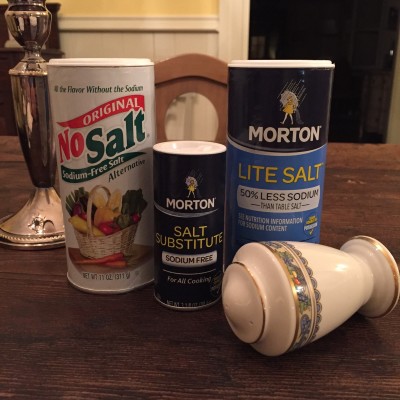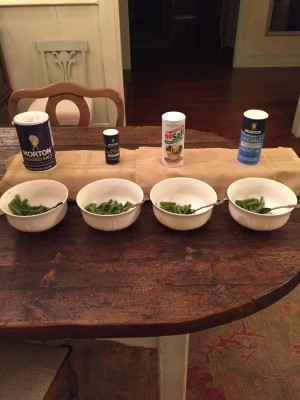
Being described as “salt of the earth,” as in Matthew 5:13, is a very good thing. But, eating salt of the earth, might not be so good for you. In addition to raising one’s blood pressure, salt can cause a person to retain water.
This may not sound so bad, but the results can look bad. Trust me! Swelling ankles are my new trick. And they do not look pretty when in full bloom.
This cankle (when calves and ankles are one) effect has caused me to seek a salt alternative.
Having a love of taste tests, I purchased three salt alternatives and a bag of fresh green beans. I also added regular table salt to the competition. We tasted four bowls of green beans, each seasoned with a different type of salt. Otherwise, the only other seasoning was a bit of freshly cracked fresh pepper and a small amount of unsalted butter. I added the exact same amount of salt to each bowl, which had the same amount of green beans in them.
The four salts were:
1. Morton’s Iodized Salt.
2. Morton’s Lite Salt (50% less sodium).
3. Morton’s Salt Substitute.
4. No Salt (sodium-free salt).
I really expected huge taste differences. I had tried salt substitutes back in the 1990s. After tastes and weird tastes were what came to mind.

What I taste was 4 pretty good salts. To me, there was no difference in the taste of the regular salt (#1) and the Lite Salt (#2). The Morton’s Salt Substitute (#3) and No Salt (#4) tasted similar. I would describe the taste a flat, metal taste. Mike said they barely tasted of salt to him. But, they did not taste bad.
Of the four salts tasted, I am willing to use any of them in my cooking and seasoning. If you aren’t already doing something to reduce your salt intake, maybe you could try an alternative to table salt. It might not be as bad as you think!

Bonus information: Did you know your body actually needs iodine? A deficiency can cause several health problems including thyroid issues. Morton salt began selling iodized salt in 1924.
